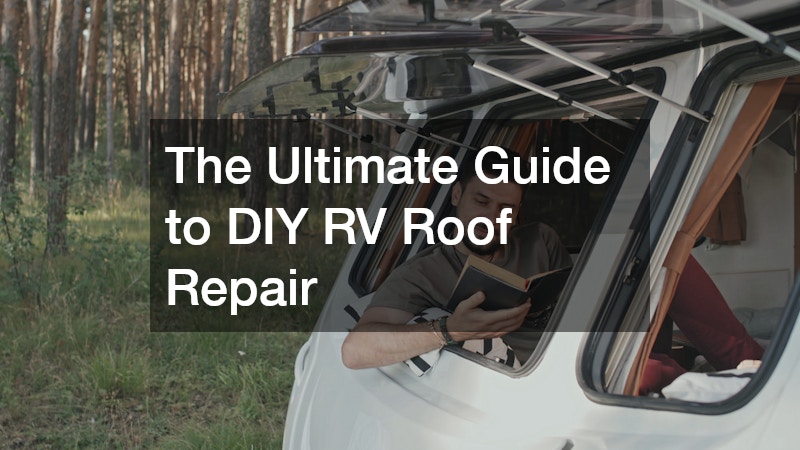In this comprehensive guide, we’ll explore how you can effectively repair the roof of your recreational vehicle (RV) yourself. Whether you’re a seasoned DIY enthusiast or a complete novice, understanding the basics of RV roof repair can help you maintain your vehicle’s longevity and ensure your travels remain safe and enjoyable. This article will address the most common questions and concerns related to DIY RV roof repair, offering step-by-step instructions and expert tips.
Visual Inspection Basics
Conducting a visual inspection of your RV roof is the first step in identifying potential issues. Walk around your RV and observe the surface of the roof for obvious signs of damage such as cracks, punctures, and discoloration.
Pay close attention to areas around skylights, vents, and any other roof penetrations as these are common sources of leaks.
Don’t underestimate the importance of regular inspections, especially after harsh weather conditions. Checking for damage early can prevent more serious problems from developing, saving you time and money in the long run. Make note of any areas that look suspicious, as these will need a closer inspection or repair.
Using Technology for Roof Inspection
Technology can greatly enhance your ability to perform thorough inspections, especially in hard-to-reach areas. Drones equipped with cameras provide an aerial view of your RV roof, capturing images and video in high detail. This allows you to assess damage without putting yourself at risk of falling.
Moreover, smartphone apps have been developed to assist with inspections by providing tools like zoom capabilities and image clarity enhancement. With the help of these apps, you can keep a detailed record of the roof’s condition over time. This can be invaluable when it comes to monitoring the progression of wear and deciding on necessary repairs.
Recognizing Different Types of RV Roof Damage
Understanding the different types of damage that can occur on an RV roof is crucial for determining the right course of action. Water damage is one of the most common issues, often caused by leaks that are left unattended. Look for signs like soft spots, stains, and mildew, which can indicate water penetration.
Another common form of damage is physical impairment from debris or overhanging branches. These can result in punctures or tears, especially on older or neglected roofs. Structural issues, such as sagging, suggest significant underlying problems that require immediate attention.
Essential Tools for DIY RV Roof Repair
Equipping yourself with the right tools is essential for a successful RV roof repair. Basic tools include a ladder, a caulking gun, and a utility knife, which are commonly needed for accessing and working on the roof. Additionally, having a roller, sealant, and repair tape on hand can streamline the repair process.
More advanced tools like a heat gun, when properly used, can help mend certain materials like EPDM. Ensuring you have the right tools not only speeds up the repair but also adds to safety and professionalism in execution. Investing in quality equipment will yield better results and more enduring repairs.
Choosing the Right Repair Materials
Choosing suitable repair materials depends on the type of roof on your RV. EPDM rubber, TPO, and fiberglass are popular materials, each with distinct maintenance and repair needs. EPDM is durable and great for most climates, while TPO offers resistance to dirt build-up and environmental pollutants.
For fiberglass roofs, consider materials specifically designed to reinforce and repair them, such as fiberglass repair kits. The choice of adhesive and sealant is equally important, as it must suit the roof material for optimal bonding. Understanding your roof’s materials ensures you select compatible and effective repair products.
Step-by-Step Repair Process
Once you’ve identified the issue and gathered all necessary materials, it’s time to begin the repair process. Start by cleaning the damaged area thoroughly to ensure the surface is clean and ready for repair. Next, apply the appropriate primer or repair tape to seal any holes or cracks.
For rubber roofs, use an EPDM-compatible adhesive along with rubber patches to cover the affected area. Carefully follow manufacturer instructions to avoid voiding any warranties. Lastly, seal around edges with a quality sealant to ensure a waterproof finish.
Post-Repair Maintenance Tips
After completing an RV roof repair, ongoing maintenance is key to ensuring its longevity. Regularly inspect the roof and repaired areas for any signs of wear, especially after adverse weather conditions. Promptly addressing minor issues will prevent them from escalating into serious problems.
With proper knowledge and preparation, DIY RV roof repair can be an empowering and fulfilling task, saving you money and extending the life of your vehicle. This guide has given you the foundational steps and necessary information to confidently inspect, prepare, and repair your RV roof. Always remember that maintaining your RV roof is a crucial part of ensuring safe and memorable travels.


